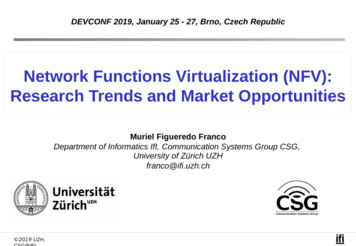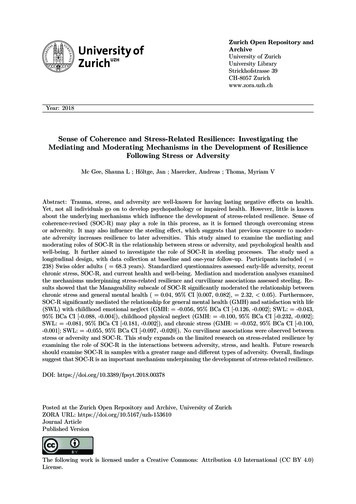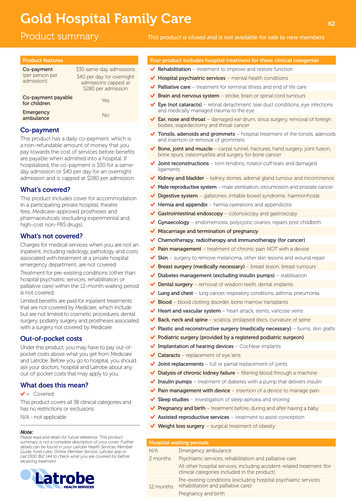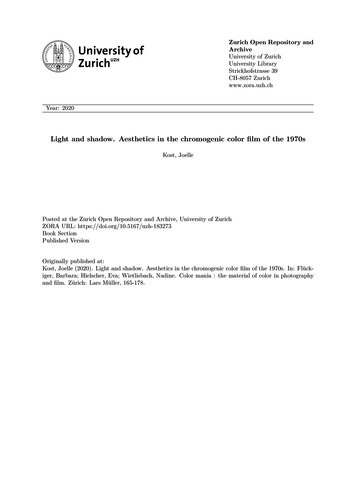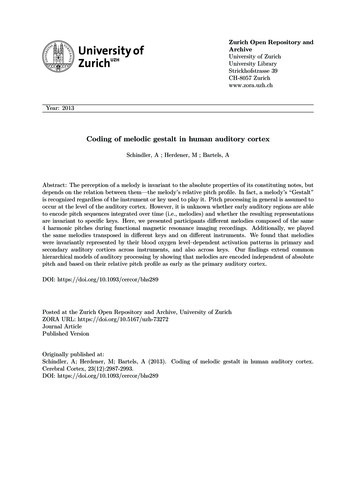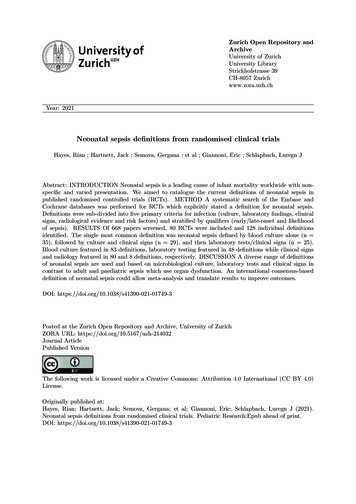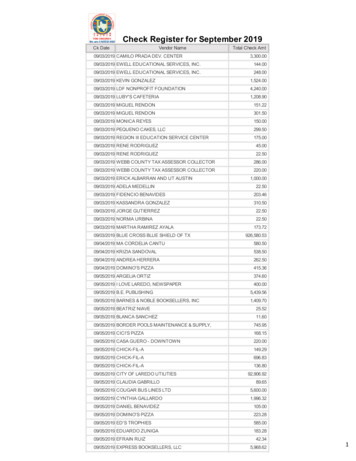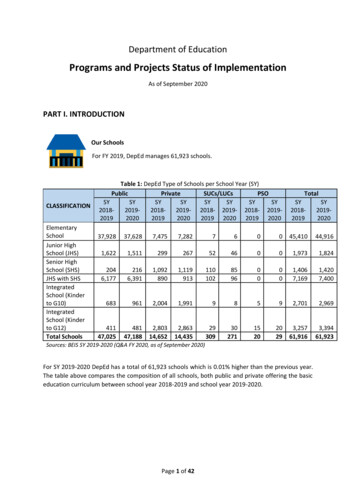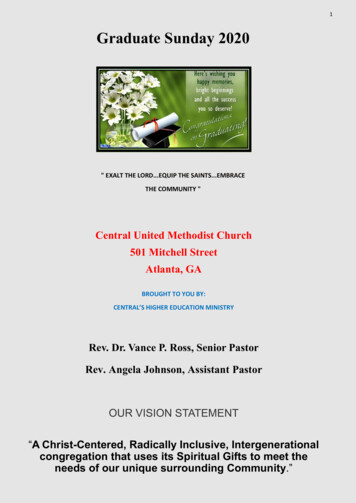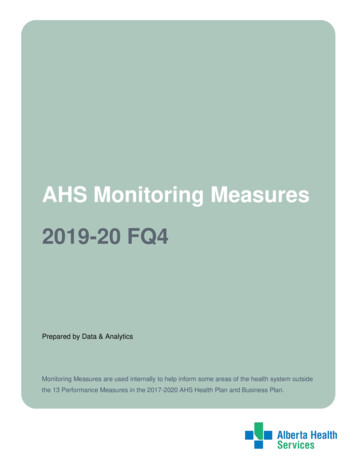
Transcription
Redundancy-free Analysis of Multi-revision Software Artifacts29million program revisions took 8.3 days at 101ms per revision on average, i.e.,close to 10 revisions per second. Calculating the per-revision runtime for eachproject in each language yields a median runtime per revision of 30ms for Java,79ms for C#, 19ms for JavaScript and 42ms for Python.Redundancy removal. The range compression technique we propose is extremely effective: The range compression factor in Table 2 reflects the ratioof the number of revision ranges in AST vertices needed to represent multiple program revisions, without loss, versus the actual number of verticesrepresented by all revisions individually. On average for each language, thiscompression ratio ranges between 0.023 and 0.041, meaning that to analyzemultiple revisions of a program, LISA needs just 4% of the memory and computational resources required to analyze each revision separately. For very largeprojects, the range compression factor can be extremely low. For example, during the analysis of the Android Platform Frameworks, the compression factorreached 0.000053. For analyzing Mono, the compression factor was 0.000105.This means that especially when analyzing large projects, the multi-revisiongraph compression saves significant overhead. But even for projects consistingonly of a few dozen revisions, the range compression factor can quickly dropbelow 0.4 for Java, C# and Python projects. For JavaScript projects, compression ratio factors as high as 0.53 were observed for very small projects.JavaScript projects are distinctively different because code is generally contained in fewer files (as reflected in Table 2); it is not unusual for an entireproject to be managed in a single file. This means that (i) the ratio of actualchanges in a single commit to the amount of source code that needs to bere-parsed is greater – even if only one line is changed in a commit, an entirefile needs to be re-parsed (i.e., changes in languages where code is spread outover a larger number of files are quicker to re-parse), and (ii) the ASTs foreach file are larger. This means that changes more easily introduce hard-toavoid redundancies. Due to how AST nodes are identified, high churn withina file – possibly at high levels in the AST – causes more vertices and rangesto be created than for languages were ASTs are shallower due to them beingdistributed across many files.When performing computations by first loading code from several revisionsand then analyzing it in a second step, selecting exactly which parts of anAST are relevant for an analysis can be extremely advantageous. The effectivefiltering factor largely depends on the parser and how it constructs ASTs.For Java and C#, using ANTLRv4 grammars, this factor is roughly 0.15 and0.11 respectively. For JavaScript as parsed by the Nashorn parser, this factoris 0.46, i.e., still less than half of all vertices are loaded into the graph. ForPython, the factor is 0.21.Performance compared to other tools. A fair one-on-one comparison to othertools is not feasible, as each tool has different feature sets, restrictions andcapabilities. In previous work [8], we compared the performance of a LISAprototype, which lacked many of the performance-enhancing techniques discussed in Section 2, except for the range compression, to two existing analysis
30Carol V. Alexandru et al.tools, namely inFusion [2] and SOFAS [34] for analyzing the AspectJ project.In that comparison, the prototype took 1:31 minutes to analyze a single revision, outperforming SOFAS by a factor of 9.8 and inFusion by a factor of 4.3.The average time needed to analyze one revision fell below 2 seconds whenanalyzing more than 100 revisions and below 900ms when analyzing more than1,000 revisions, whereas using the other tools, each additional revision to beanalyzed incurs the same cost, which actually increases with the growth of theproject in later revisions.We can however compare the performance of LISA directly to the originalprototype and by extension, to the tools used in the original study [8]. Toanalyze all 7,778 revisions of AspectJ, the prototype spent 650ms on averageper revision, while LISA spent only 45ms. Of this, the original prototypespent more than 500ms on parsing and graph building, and around 80mson the analysis. LISA on the other hand spent 31ms on parsing and 4ms onthe analysis. The resulting average of 45ms per revision (including metadataextraction and persistence) is just above the median average across all Javaprojects we analyzed, as shown at the bottom of in Table 2.The parsing speed improvement can be attributed to both the filteredparsing, enabled by the lightweight mappings (Section 2.3), the asynchronousmulti-revision parsing algorithm and the parallelized Git metadata retrieval(Section 2.1) and persistence (Section 2.2). The original prototype stored theentire parse trees as provided by the parser and could only parse files for onerevision at a time. The analysis speed improvement is directly connected tothe filtered parsing, as the signals need to travel much shorter distances withinthe graph.3.3 Measuring the performance benefit of individual featuresWe wanted to determine the impact of each individual redundancy removaltechnique implemented in LISA. Some of the impact, namely the compressionratio achieved by the multi-revision graph representation and the reductionin file access through the incremental approach, can be quantified by simplyobserving the metrics reported by LISA. However, to also measure the impactin terms of actual performance benefits, we needed to suppress each of theoptimized features described in Section 2 and make a one-on-one comparisonbetween the optimized version and each handicapped variant.Creating and comparing handicapped versions of LISA. We did this by creating separate source branches10 of LISA, with one individual part of the librarycode replaced by a more common, less optimized implementation, and thencompiling a drop-in replacement JAR used during the computation. Thus, weintroduced the following handicaps:10These are the handicap-* branches visible in the LISA open source repository
Redundancy-free Analysis of Multi-revision Software Artifacts31Table 3: Impact of redundancy removal techniques on total execution time.VariantOptimized LISAAnalyzing revisions individually (A)Parsing sources in sequence (B)Not filtering AST node types (C)Runtime [hh:mm]Slowdown factor0:15h15:09h0:42h2:25h1.057.82.77.1(A) checking out each revision into a working directory, instead of readingthem directly as blobs from the Git database, and thus analyzing eachrevision in sequence,(B) parsing source code of different revisions in sequence, instead of parallelizing the parsing across all revisions,(C) loading all AST vertices provided by a parser into the graph instead ofdiscarding irrelevant nodes.Effectiveness of different techniques. The results of all comparisons summarized in Table 3 highlight that each individual technique contributes significantly to the runtime reduction.Specifically, from the runtime statistics, we learn that by sharing stateacross multiple revisions at the level of AST nodes, LISA represents the complete state of the project in every revision using just 0.3% of the nodes thatare actually present across all revisions, without any information loss. We alsolearn that by not parsing and analyzing each revision individually, only 0.7%of files and 2.8% of lines (those with actual changes) needed to be read.Handicapped variant A needs over 15 hours to analyze all 7,947 revisionsof Reddit in sequence, compared to LISA’s 16 minutes, a factor of 57.8. Allelse being equal, parsing source code of different revisions in sequence as doneby handicapped variant B impacts the analysis duration by a factor of 3.2:the handicapped variant needs 37 minutes to parse all revisions, while LISAonly needs about 12 minutes. This affects the total runtime by a factor of2.7, as the handicapped variant needs 42 minutes to execute. By not filteringthose AST nodes which are unnecessary for a particular analysis, 4.2 timesmore nodes needed to be stored and involved in the computation, as done byhandicapped variant C. The execution needed 3.5 times more operations andtook 7.1 times longer, for a total runtime of 2 hours and 25 minutes insteadof LISA’s 16 minutes.3.4 Resource requirementsLISA stores the entire multi-revision graph and all computed data in memory.The majority of projects on GitHub, even among popular ones, are fairly smalland could be analyzed on commodity hardware. However, projects with manyrevisions or a large code base can require significant amounts of memory andit is hard to guess, how much is needed, exactly. To better estimate how many
32Carol V. Alexandru et al.resources in terms of memory and CPU power LISA requires for analyzing aparticular project, we designed the following three experiments.Experiments. We designed two experiments to learn about LISA’s memoryconsumption and one to determine the impact of available CPU power. Profiling memory consumption of the JVM is non-trivial mainly due to the autonomy of its garbage collectors in deciding how to manage memory and thepossibility of transparently shared memory (e.g., when using Strings or otherimmutables). In LISA, we use the G1 garbage collector (G1GC) as we foundit to provide the best performance. However, this concurrent garbage collector(GC) behaves differently under different circumstances. It desperately triesto free memory even when almost no ‘real’ work is being done and memoryallocation largely depends on the amount of available memory. Furthermore,the JVM over-allocates memory in batches. Memory consumption could bemonitored by simply observing the consumption of the JVM at the operatingsystem level, but this would be inaccurate because of how the JVM overallocates memory. GUI tools such as VisualVM or JProfiler could be used, butthis would be hard to automate. Another option would be to write a customjava agent to read out memory statistics using the Java Management Extensions (JMX), but finally we chose to use the GC log and simply observe howmuch memory the GC recognizes as containing ‘live objects’. This gives a fairlyreliable reading because the measurement is done directly during garbage collection. Based on this, we performed the following three experiments on asubset of the projects in our large-scale study:1. Experiment 1 (full memory): We re-ran the analysis of each projectproviding the full 512 GB of memory and 32 cores, like in the original largescale study. We enabled GC logging and stored the logs for each analysis.This allows us to observe how much memory LISA allocates and uses underideal circumstances.2. Experiment 2 (limited memory): Here, we re-ran the analyses threetimes, again providing 32 cores, but lowering the available memory to128 GB, 32 GB and 8 GB. We also limited the total runtime to 3 hours.This allows us to observe behavior when memory availability is low, namely(i) projects that can no longer be analyzed within reasonable time, and(ii) the impact on resource allocation, garbage collection, and hence, overall performance.3. Experiment 3 (limited CPU): In this last experiment, we provided thefull 512 GB for all analyses, but limited the number of available CPU coresto 16, 8 and 2, respectively. This allows us to accurately determine howwell LISA makes use of additional computing resources.All experiments were performed on the same hardware as the large-scale study.Even though memory and CPU cores have been reserved for exclusive use,some variability is expected, because the infrastructure is still a shared environment with other users running compute jobs on the same hardware.
Redundancy-free Analysis of Multi-revision Software Artifacts33Table 4: Projects selected for the resource rasologyJetBrains IdeaVimCrawler4JAndroid AppMsgMono DevelopPowerShellAspNet rryPi.NetYui3PlotlyLeafletnoVNCParse ServerSaltstackAnsibleEventletFacebook PathPickerJinja Assets CompressorElasticsarchApache GroovyQueryDSLGoogle J2ObjCBukkitDotNet CorefxMediaBrowser EmbyCastleproject CoreAspNet MVCNewtonsoft.jsonYui3Jquery MobilePaper.jsUnitech PM2Parsley.jsTheanoMozilla KumaBotoThunderPikaProject selection. We wanted to select projects for each language across a widerange of sizes, including both small and very large projects. However, we alsowanted to compare the resource consumption across different languages, thusthe selected projects from different languages should be comparable in size.To achieve both these goals, we applied the following selection strategy:1. For each of the four programming languages in our large-scale study, wesorted the projects twice: once according to the number of revisions analyzed, and once according to the total number of files parsed during theanalysis. We believe that these two metrics may serve as good proxies forthe total amount of work necessary.2. For each of these two metrics, we compared the four resulting sorted listsand determined the maximum value for which comparable project exist inevery language. For both the number of revisions and the number of filesparsed, the Yui3 project turned out to be the largest JavaScript projectavailable (whereas larger projects exist for the other languages, which wedid not include in the study because JavaScript projects of correspondingsize were not available).3. We selected projects with comparable metrics for the other three languages.These projects serve as the upper bound within each metric.4. Finally, we selected 4 additional projects for each language and metric,each successive one being smaller by a constant factor. We found that 2for the number of revisions and 10 for the number of lines parsed gave usa good distribution across all project sizes.As such, we ended up with 10 projects per language, where 5 were selectedaccording to the number of revisions and 5 according to the number of linesparsed and the requirement to have a similarly-sized counterpart in the other3 languages. Table 4 displays the selected projects.Note that the smallest projects included in this study are still comparatively big. 75% to 81% of projects in our dataset have fewer than 1.5K revisions.In terms of lines parsed, 7% to 40% of projects (depending on the language)are smaller. We did not choose even smaller projects, because in our experience, LISA can easily deal with smaller projects even on low-end machines,which we confirm in this study.
34Carol V. Alexandru et al.Duration (h)Fig. 7: Peak size of allocated objects on the heap as reported by the G1 garbagecollector for projects of different sizes. Note that the number of lines refersto the amount of code actually parsed for the analysis. The real amount ofsource code represented by all revisions is larger by several orders of magnitudeas described in Table ng datacomputationparsinggit metadata extractiongit clone512128328Available memory (gigabytes)Duration (h)Fig. 8: Analysis runtimes for the medium-sized PowerShell C# project (5,554revisions, 17,330,091 lines parsed representing 3,263,786,422 lines in all revisions) on server instances with different amounts of memory, all running on32 CPU 0:00persisting datacomputationparsinggit metadata extractiongit clone32168Number of CPU cores2Fig. 9: Analysis runtimes for the medium-sized Mozilla Kuma Python project(13,954 revisions, 1,231,549 lines parsed representing 1,304,524,320 lines in allrevisions) on server instances with different numbers of cores, all running with512 GB of memory.
Redundancy-free Analysis of Multi-revision Software Artifacts35Experimental results. Figure 7 displays the results of the first experiment. Unsurprisingly, larger projects need significantly more memory to be processed.That said, the memory requirements for different projects with similar sizemetrics may still heavily diverge. For example, the four projects with roughly15M lines parsed required between 40 GB and 220 GB of memory duringanalysis. From the second experiment, we learn that additional memory doesnot accelerate the computation for projects where more memory is availablethan required. Figure 8, however, shows that when the available memory isjust barely sufficient, the processing time increases significantly. Analyzing themedium-sized PowerShell project with only 8 GB of memory available doubledthe processing time, since the garbage collector needed to constantly free upmemory. Larger projects either crashed with an out-of-memory error or timedout after 3 hours, which is reflected in Figs. 10 and 11. In terms of size, itappears that projects with up to 3,000 revisions and 1.5M lines parsed can beanalyzed on basic commodity hardware (this covers 82% of the 4,000 projectswe analyzed). The third experiment gave us both expected and unexpectedresults. Figure 9 shows that the total processing time steadily decreases from1:40h using 2 cores to 30min using 8 cores and 15min using 16 cores. Surprisingly, using 32 cores increased the processing time. A similar trend is visiblein Figs. 12 and 13. Even more surprisingly, the computation time shown inFigure 9 was halved from 16 to 32 cores, while the parsing time doubled. Wediscovered that this was caused by a flaw in the configuration of LISA, in thatit uses a fixed-size pool of 28 workers to parallelize parsing (while during thecomputation, it uses a number of workers equal to the number of availablecores). It appears that this causes no problems when there is a lower numberof cores available, i.e., some workers share the same core. However, when thereis a larger number of CPUs available, performance is negatively impacted.This might simply be due to the workers not getting pinned to a specific corewhich reduces the efficiency in memory access and caching. We plan to furtherinvestigate this issue and mitigate it in a future release of LISA.Memory is the main limiting factor in analyzing large projects using LISA.However, it remains difficult to estimate in advance, how much memory isneeded. We discuss possible solutions to this problem in Section 4.2.3.5 Adapting LISA to other programming languagesAs a final demonstration of LISA’s adaptability, we go through the process ofadding support for another programming language, namely Lua, to LISA.11 Asdiscussed in Section 2.3, programming languages share some similarities, especially regarding structure (like how different AST node types are nested), eventhough they use different grammars and absolutely differ in certain ways. Forexample, Lua does not have classes as a language-level concept. Nevertheless,11 This demonstration is part of the lisa-quickstart repository: https://bitbucket.org/sealuzh/lisa-quickstart/
tion (h)Carol V. Alexandru et al.Duration (h)36512 128 32 8Available memory (gigabytes)150M15M1.5M150K15K32 16 82Available CPU coresFig. 12: Runtimes of JS projects witha different number of lines parsed.Fig. 11: Runtimes of C# projects witha different number of revisions.Duration (h)Duration (h)25K13K7K3K1.5K512 128 32 8Available memory (gigabytes)Fig. 10: Runtimes of JS projects witha different number of lines K1.5K32 16 82Available CPU coresFig. 13: Runtimes of C# projects witha different number of revisions.other object-oriented analyses implemented in LISA still apply, for examplecounting attributes or computing cyclomatic complexity of functions and files.Implementation. Listing 5 contains the complete implementation and demonstrates how little work is necessary to support additional languages in LISA.The following steps are necessary.1. Copying an existing ANTLRv4 grammar into the src/main/antlr4 directory. We used the grammar made available at https://github.com/antlr/grammars-v4.2. Defining a language mapping from the symbols used by the object-orientedanalysis suite to the labels used in the grammar (lines 15 to 26).3. Defining the boilerplate class which integrates the ANTLR-generatedparser in LISA (lines 28 to 33).The implementation took us roughly 30 minutes, mainly to look up and mapthe labels used by the ANTLR grammar. Using this minimal implementation,LISA’s generic analyses (which are part of the UniversalAnalysisSuite usedon line 44) can thus be applied to Lua projects. Metrics for any matchingnode types (i.e., methods, blocks and files) will be computed. Nothing moreis necessary to persist these metrics at the file level. However, if the goal is topersist metrics for individual functions, a little more work is necessary. Theproblem is, that in this Lua grammar, function names are not stored as literalsof the function nodes (labeled “Function” by the grammar). Instead, theyare stored in child nodes, labeled “Funcname”, beneath the function nodes.This means that to identify function nodes by their name, it is necessary tosignal the function name from the “Funcname” to the actual “Function” nodes,
Redundancy-free Analysis of Multi-revision Software Artifacts37Listing 5: Adding Lua support in 8293031323334353637383940414243444546474849package org . exampleimport ch . uzh . ifi . seal . lisa . core .import ch . uzh . ifi . seal . lisa . core . public .import ch . uzh . ifi . seal . lisa . antlr .import ch . uzh . ifi . seal . lisa . module . analysis .import ch . uzh . ifi . seal . lisa . module . persistence . CSVPers istence// Parser classes generated by ANTLRv4 . Beyond copying the grammar into// the correct directory , no additional effort is necessary , as LISA// automatically generates parsers for available grammars .import org . example . parser . LuaLexerimport org . example . parser . LuaParser// Mapping semantic concepts used by the existing object - oriented// analyses ( Scala symbols on the left ) to parser - specific labels , as// found in the Lua grammar file ( sets of strings on the right ).object LuaParseTree extends Domain {override val mapping Map ('file- Set ( " Chunk " ) ,'block- Set ( " Block " ) ,'statement - Set ( " Stat " ) ,'fork- Set ( " DoStat " , " WhileStat " , " RepeatStat " , " IfStat " ," ForStat " , " ForInStat " ) ,'method- Set ( " Function " ) ,'variable- Set ( " Var " ) ,'field- Set ( " Field " ))}// Boilerplate wrapping the ANTLR generated parser for use with LISAobject Antlr LuaPars er extends AntlrParser [ LuaParser ]( LuaParseTree ) {override val suffixes List ( " . lua " ) // which blobs to read from Gitoverride def lex ( input: A N T L R I n p ut S t r e a m ) new LuaLexer ( input )override def parse ( tokens: C o m m o n T o k e n S t r e a m ) new LuaParser ( tokens )override def enter ( parser: LuaParser ) parser . chunk ()}// This remaining code is not necessary for adding support . It simply// shows how the newly added parser is used to analyze a Lua project .// The U n i v e r s a l A n a l y s i s S u i t e contains LISA's object - oriented analyses// which operate on the semantic concepts mapped above .object LuaAnalysis extends App {val url " https: // github . com / Mashape / kong . git "implicit val uid " Mashape kong "val gitLocalDir s " / tmp / lisa / git / uid "val targetDir s " / tmp / lisa / results / uid "val parsers List [ Parser ]( An tlrLuaP arser )val analyses U n i v e r s a l A n a l y s i s S u i t eval persistence new CSVPers istence ( targetDir )val sources new GitAgent ( parsers , url , gitLocalDir )val c new Li s aC om pu t at io n ( sources , analyses , persistence )c . execute}where the metrics are computed. This requires an additional 18 lines of code.See https://goo.gl/YnNd7j for an extended version of the Lua support thatincludes name resolution. Note that this really is only necessary if functionsneed to be identified in the resulting data set.Discussion. Whereas the formulation of analyses can be rather verbose, as indicated in Section 3.1, adding support for additional languages is very straightforward and simple in LISA. Besides the redundancy removal techniques, theflexibility to easily support additional languages is a major benefit of usingLISA. That said, in our experience, the performance of ANTLR-generatedparsers can vary significantly. Sometimes, it is better to use a native or oth-
38Carol V. Alexandru et al.erwise optimized parser. Adding an external parser is more work than justcopying a grammar file, but LISA’s interface is straight-forward to implement. For reference, integrating the native Python parser required 134 lines ofScala and 80 lines of Python code. Integrating the JRE’s Nashorn JavaScriptparser required 168 lines of Scala code. That said, especially for exploratoryresearch in the beginning of a study, having the option of simply dropping inan ANTLR grammar to apply LISA is a significant advantage.3.6 Threats to validityWe presented several experiments that demonstrate the effectiveness of theredundancy removal techniques we describe in Section 2 and thus, the capabilities and usefulness of LISA. Our conclusions in these experiments relyon our tooling and the experimentation methodology applied. Even thoughwe designed the experiments diligently, their validity might be threatened forseveral reasons.Internal validity. This relates to factors or effects on the experiments thatinfluence the results, but that are not controlled. Ignoring these factors canchange the interpretation of the results and the conclusion.Our findings are based on metrics that we compute using LISA for a largenumber of projects and we rely on the correctness of these computations. Weensure their correctness by running them in a controlled environment and bycomparing the results to manually calculated results. Human calculation errorshave been mitigated by double-checking of the results.In the same way, it could be that we are missing an effect that would leadto an incorrect measurement of the reported runtimes for the experiments.However, as the same methodology is used to compare the runtimes of theoptimized and the handicapped version of the experiments, such an error wouldnot favor one approach over the other. We ran each experiment once only andnot several times (averaging the results), however we are still confident thatour measurements provide an accurate representation of how the handicappedversions compare.The hardware we ran our experiments on is a shared environment, andeven though resources are reserved for a process, other jobs running on thesame hardware can interfere with LISA’s performance. Furthermore, due toan existing bug in LISA, performance benefits when using more than 28 coresseem to be limited. However, all projects in the large-scale study were analyzedusing the same resources.External validity. The generalizability of our findings to other experimentalsettings are affected by threats to the external validity of our experiments.The choice of projects used in our experiments might be biased and not representative for other projects. To mitigate this issue, we selected a large sampleof popular open-source projects and we analyze four different programminglanguages. Our sample covers a wide range of application domains, project
Redundancy-free Analysis of Multi-revision Software Artifacts39sizes, history sizes, and levels of activity, which makes us confident that our results generalize beyond our immediate findings. However, all selected projectsare open-source. While some of them are maintained by professional developers, we cannot assume that the same results will be found in closed-sourceprojects. Furthermore, since we chose projects based on popularity, it maybe that less popular projects behave differently or yield different aggregatedresults. We may replicate our study for additional projects and programminglanguages in future research to extend the generality of our findings.All our experiments use the domain of static source-code analyses as ameans to evaluate LISA and we assume that these analysis tasks are representative for other domains as well. Graphs that are constructed for answering different questions and which are based on artifacts other than plain-textsource code (e.g., bytecode or on-save snapshots from an IDE) may have different topologies which could impede the effectiveness of the algorithm andlead to reduced performance. However, the underlying graph framework usedby LISA, Signal/Collect, does not impose any limitation on the kind of graphthat is processed. We do not expect that other kinds of analyses would benefitless from using LISA.4 DiscussionWe have presented several techniques and demonstrated their effectiveness.Here, we first reflect on what role a tool such as LISA plays in software evolution research by reporting on two artifact studies we performed. We thenaddress how we can further improve LISA, and assess its potential for futurestudies.4.1 Artifact studiesWhile the focus of our research is on finding ways to reduce redundancies inmulti-revision analyses, thus accelerating them, the ultimate purpose of anysoftware analysis tool is to answer concrete questions. So far, we have usedLISA in two different artifact studies.Study A: sampling revisions in software evolution research. In this first study,we asked the question, how many revisions in the history of a project can‘safely’ be skipped when doing software evolution research without losing toomuch information. While LISA can perform certain analyses on every revisionof a project, other, more resource-intensive tools may not, such that researcherswill need to consider a trade-off between the numbe
redundancy in software evolution analysis itself. A second problem involving redundancy is the analysis of projects consist-ing of different programming languages. Not all, but many software analysis tools are limited to one specific language (e.g., linters, bug detection tools and
